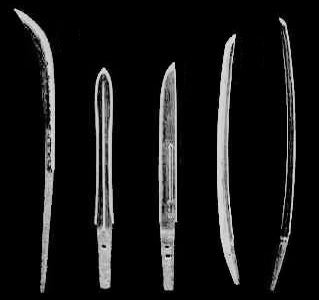Your Cart is Empty


The Japanese katana is one of the world's most popular and recognized swords. Regardless of your expertise in historical swords, you probably know that it features a curved blade. In feudal Japan, swordsmiths created a variety of swords with curved blades to achieve a more effective weapon. Swords with curved blades are easier to draw and have a better angle of attack when compared to their straight-bladed counterparts.
However, the shape and form of Japanese swords has evolved throughout the country's history.
Bronze Age
Appearing during the Bronze Age, some of Japan's first swords featured similar geometric characteristics as those produced by its neighbors in China and Korea. Swordsmiths during this era classified their swords as having either one or two edges. Single-edged swords were known as tō and double-edged swords were known as ken.
The Evolution of Single-Edged Swords
While Japanese swordsmiths created both single- and double-edged swords, the latter ultimately become the dominant and preferred style. Though featuring two edges instead of one, double-edged swords weren't particularly effective. Rather than creating and maintaining just one edge, swordsmiths had two edges to create and maintain. This, of course, meant twice the work.
Furthermore, this was a time during which Japanese swordsmiths began experimenting with curved blades. Swords featuring a curved, double-edged blade were more susceptible to breakage than those made with just a single blade. These factors ultimately led to the domination of single-edged swords in feudal Japan.
Enter the Chokutō
The chokutō later emerged as a popular design for Japanese swords. It featured a slightly curved, single-edged blade and was designed for use with one hand. Normally, the chokutō featured a relatively small handle measuring just a few inches. It also featured a prominent sword guard on the front and sides to protect the user from self-injury.
Of course, the chokutō wasn't an entirely unique design. Like other Japanese swords of this era, it shared features and characteristics to Chinese swords, especially those produced during the Warring States and Han Dynasties.
The Katana
Around the Tang Dynasty, the chokutō had faded from popularity while subsequently paving the way for the modern-day katana. Like the chokutō, the katana featured a curved, single-edged blade. However, it was a more prominent curve with a longer blade. The chokutō was designed for use with one hand, for instance, while the katana was long enough to be used with one or two hands.
Today, the katana remains the preferred geometric format for creating Japanese swords. Its curved, single-edged blade has become synonymous with quality swords.